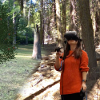From spatial to platial - the role and future of immersive technologies in the spatial sciences
Keywords:
immersive technologies, extended realities, virtual reality, embodiment, affordances, spatial presence, flowAbstract
Immersive technologies such as virtual and augmented reality have been part of the technology mindset in computer and geospatial sciences early on. The promise of delivering realistic experiences to the human senses that are not bound by physical reality has inspired generations of scientists and entrepreneurs alike. However, the vision for immersive experiences has been in stark contrast to the ability to deliver at the technology end; the community has battled nuisances such as cybersickness, tethers, and the uncanny valley for the last decades. With the 'final wave' of immersive technologies, we are now able to fulfill a long-held promise and freely and creatively envision how immersive technologies change spatial sciences by creating embodied experiences for geospatial applications. These experiences are not restricted by time or place, nor are they limited to the physical world. This contribution envisions the future of spatial sciences in light of place-like experiences enabled through immersive technologies and their potential to infuse research in the spatial sciences community.

Downloads
Published
Issue
Section
License
Copyright (c) 2020 Alexander Klippel

This work is licensed under a Creative Commons Attribution 4.0 International License.
Articles in JOSIS are licensed under a Creative Commons Attribution 3.0 License.
